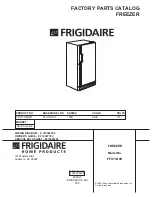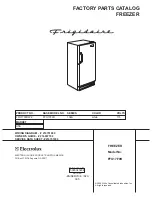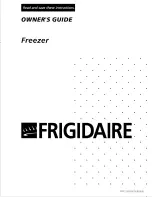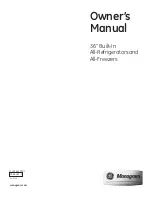
9
Cleaning Your Freezer
• Upon installation of your new appliance, we recommend that it be cleaned thoroughly.
• Unplug the freezer, remove the stored items and storage basket(s).
• Wash the inside with a damp warm cloth moistened with a water and baking soda solution.
(Dissolve 2 tablespoons of baking soda in a quart of water.)
• Wash the storage basket with a mild detergent solution.
• To keep the unit running efficiently, be sure to keep the door gasket (seal) clean.
• The outside of the freezer should be cleaned with mild detergent and warm water.
• Dry the interior and exterior with a soft cloth.
• The condenser coils at the back should be vacuumed when they are dusty or dirty.
• It is recommended that the unit be cleaned each time it is defrosted to help keep the unit odor-
free and running efficiently.
Vacations
•
Short vacations:
Leave the freezer operating during vacations of less than three weeks.
•
Long vacations:
If the appliance will not be used for several months, remove all items and
unplug the power cord. Clean and dry the interior thoroughly. To prevent odor and mold growth,
leave the door open slightly, blocking it open if necessary, or have the door removed. Use
extreme caution in the case of children. The unit should not be accessible to children at play.
Power Failure
NOTE:
Do not open freezer door unnecessarily if freezer is off for several hours.
If a power failure occurs, frozen items will stay frozen for at least 24 hours if the freezer is kept
closed. If the power failure continues, pack seven or eight pounds of dry ice into the freezer every 24
hours. Look in the Yellow Pages under Dry Ice, Dairies, or Ice Cream Manufacturers for local dry ice
suppliers. Always wear gloves and use caution when handling dry ice.
Moving Your Freezer
• Remove all the stored items.
• Securely tape down all loose items inside the freezer.
• Tape the door shut.
• Be sure the freezer stays in the upright position during transport.
Energy-Saving Tips
• The freezer should be located in the coolest area of the room, away from heat- producing
appliances or heating ducts, and out of direct sunlight.
• Let hot items cool to room temperature before placing in the freezer. Overloading the freezer
forces the compressor to run longer. Items that freeze too slowly may lose quality, or spoil.
• Be sure to wrap all items properly, and wipe containers dry before placing them in the freezer.
This cuts down on frost build-up inside the freezer.
• The freezer's storage bin or baskets should not be lined with aluminum foil, wax paper or paper
toweling. Liners interfere with cold air circulation, making the freezer less efficient.
• Organize and label all stored items to reduce door openings and extended searches. Remove as
many items as needed at one time and close the door as soon as possible.
TROUBLESHOOTING







































